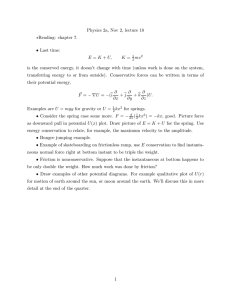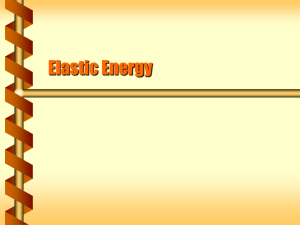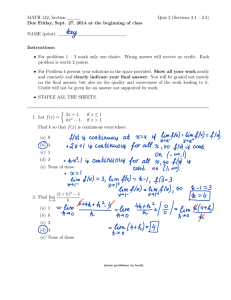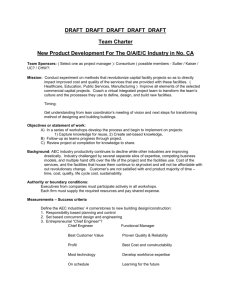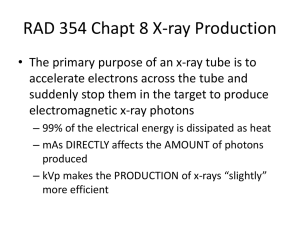Document 14318824
advertisement
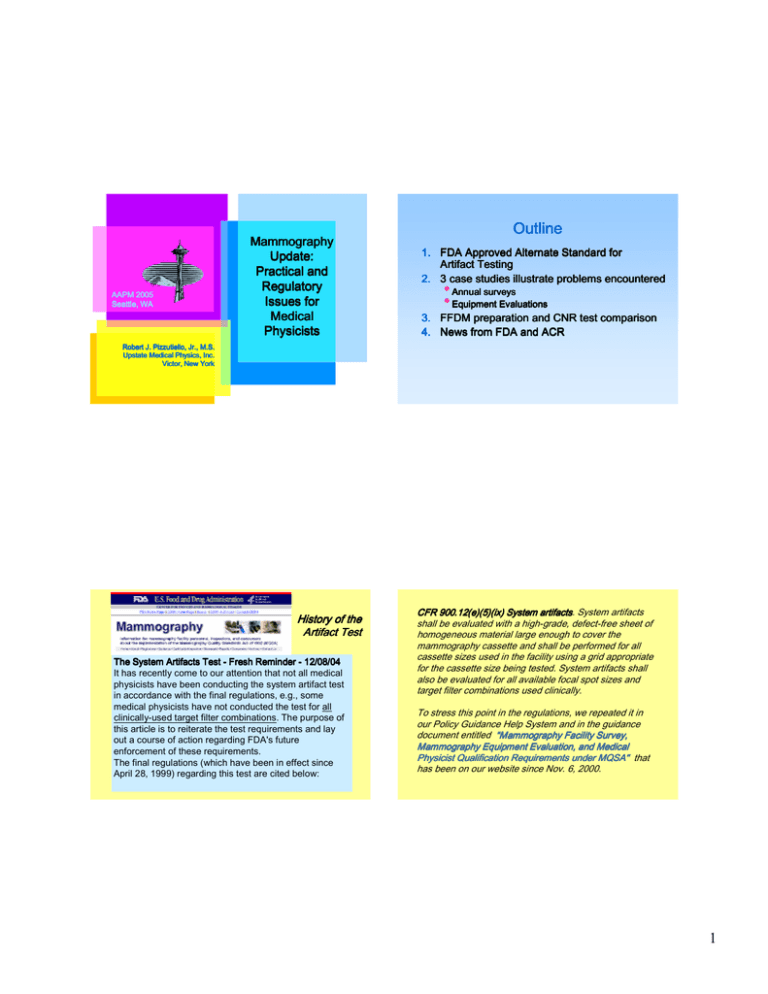
It has recently come to our attention that not all medical physicists have been conducting the system artifact test in accordance with the final regulations, e.g., some medical physicists have not conducted the test for all clinically-used target filter combinations. The purpose of this article is to reiterate the test requirements and lay out a course of action regarding FDA's future enforcement of these requirements. The final regulations (which have been in effect since April 28, 1999) regarding this test are cited below: 1 • 900.18(c)(1)(2)(3)(4)(5)(6): An application for approval of an alternative standard or for an amendment or extension of the alternative standard shall be submitted in an original and two copies to ... The application for approval of an alternative standard shall include the following information: – (1) Identification of the original standard for which the alternative standard is being proposed and an explanation of why the applicant is proposing the alternative; – (2) A description of the manner in which the alternative is proposed to deviate from the original standard; – (3) A description, supported by data, of the advantages to be derived from such deviation; – (4) An explanation, supported by data, of how such a deviation – – would ensure equal or greater quality of production, processing, or interpretation of mammograms than the original standard; (5) The suggested period of time that the proposed alternative standard would be in effect; and (6) Such other information required by the Director to evaluate and act on the application. 2 Applicants for Alternatives • Citation: • 900.18(b)(1)(2)(3): Applicants for alternatives. • (1) Mammography facilities and accreditation • • bodies may apply for alternatives to the quality standards of section 900.12. (2) Federal agencies and State governments that are not accreditation bodies may apply for alternatives to the standards of section 900.12(a). (3) Manufacturers and assemblers of equipment used for mammography may apply for alternatives to the standards of sections 900.12(b) and (e). 3 The latest news… 1. 2. 3. 4. 5. 6. 7. Conducting the daily processor QC tests when the sensitometer is not available Continuous display of the override status for machines with decompression devices Conducting the weekly phantom image test at facilities with intermittent mammography operation Post exposure indication of the machine preselected focal spot and or target material Verification Testing After Certain Modifications of the AEC of Senographe™ 700T, 800T, DMR Mammography Systems Conducting the Mammography Equipment Evaluation After a Software Upgrade Under Medical Physicist Oversight Correction Period When Components of the Senographe ™ 2000D FFDM System Fail QC Tests 4 8. 9. 10. 11. 12. 13. 14. 15. Combined Mammography Medical Outcomes Audit for Multiple Mobile Mammography Units Separate Assessment of Findings For Each Breast Correction Period When Components of the Selenia FFDM System Fail QC Tests Amendment to the Alternative Requirement for the Correction Period When Components of the Senographe ™ 2000D FFDM System Fails QC Tests Modifications in the Assessment Categories Used in Medical Reports Assessment category for "Post Procedure Mammograms for Marker Placement“ System Artifact Testing at Remote Mobile Mammography Sites Where Film Processing Takes Place Using Processors Permanently Located at the Site. System Artifact Testing of Target Filter Combinations 5 Part 2 Case 1 – The Hefty HVL The importance of careful technique. • Equipment Evaluation after tube replacement on Bennett Contour 2000 • 32 kVp Mo/Mo HVL exceeded the permissible kVp/100 + C • Repeated measurements and found the same problem. • What could be the problem? A few case studies from which to learn …. • Possible sources of problem – kVp too high – Incorrect filter installed – Meter malfunction – Something else hardening the beam • Process to solve problem – Find an error in my technique – Have facility call QSE to correct – I always try to eliminate myself as a source of error first • Look at other HVL data – All values for this machine survey are somewhat higher than usual – 32 kVp Mo/Mo beyond permissible range – 28 kVp Mo/Mo also higher than usual – All values higher than last year • Is Radcal malfunctioning? – Re-checked data from previous 3 surveys – ESE and AGD look fine at 25.5 kVp, Mo/Mo • Any indication of incorrect filter? – Image contrast looks fine 6 • Critically examine the experimental set-up • Compression paddle is only about 20 cm above ion chamber – the upper limit of travel before the machine automatically senses “magnification” mode • Repeated measurements with Aluminum near x-ray tube port • HVL is fine, and all other HVL’s lower 1. Maximize distance between Al sheets and the ion chamber 2. Tape Al to tube port 3. ….or use magnification paddle 4. Similar problem with 1. Instrumentarium Alpha IQ 2. Siemens 3000 Nova 5. Remember to check “Human Factors” first! Case 2 – Annoying AEC • During follow-up testing after AEC recalibration • AEC failure on Lorad M-IV • AEC selects 27 kVp Mo/Rh in Auto filter mode • During AEC testing, kVp’s are very high and exposure times are long 7 • Possible sources of problem – kVp too low – AEC cal file corrupted – Thickness inaccurate, below “threshold” – Something else… • “Threshold” for Lorad M-IV – Typically set to ~3.5 cm – Switches from 100 mA to 30 mA for contact imaging of thin breasts – An engineering “fix” to problems with early Lorad M-IV’s “exposure time too short” for HTC grid motion • Thicknesses were accurate • But somehow, exposure times were long consistent with lowered mA • Solution – In-house biomed engineers obtained replacement compression paddle from 3rd party source – Reflective metal strips on back were incorrect, selecting Magnification mode and 20 mA – AEC Auto filter mode selected kVp for magnification imaging – Verified by replacing old “cracked” paddle – AEC and kVp OK Case 3 – Languishing Line-Pairs 1. Ask if anything has changed, since last survey, or recent history of problems A. Site didn’t mention – assumed we would check out the new paddle as part of our testing 2. Post “Threshold” thickness on operator’s console 3. Review this with RT’s (rarely well understood) 4. Use all our senses (long exposure time could have been a clue) 5. Remember Human Factors – keep in mind the expertise of “QSE” • Friday – Routine Annual Survey • Near the end of annual survey, asked RT “which hole do you use for magnification” • RT is confident that “top holes” are used – 1.9x is displayed • “My recollection is top holes are used only for SBB add-on device” • Line pair resolution fails for both focal spot sizes, Mo and Rh targets • Dinner plans in jeopardy, but hopeful for a reasonable solution 8 1.9x 1.8x 1.5x • Tuesday AM – Tube arrives, “come at 2 PM” • Bob calls at noon – Trusted service engineer says “come at 4 PM” • …………not a good sign • Dinner again in jeopardy • Engineer assures everything OK • Start at 5 PM – full MEE • At 7 PM, test small FS LP resolution • Rh filter fails • Repeat test 3 times at various magnifications - FAILURE • Consult with department manager • Order 2nd new x-ray tube, move tomorrow’s Dx cases • Engineer orders LP pattern, to test before I arrive next time • Home 10 PM, no dinner (better than McD) • Repeat test at 1.8x (mid holes) and 1.5 x (bottom holes) • Rh target, small FS LP FAILURE • Consult with department manager • Recommended (though not required) to reschedule tomorrow’s Dx cases • Order 2nd x-ray tube • Got home late, missed dinner with guests, ate at McDonald’s • ….paid for it all night • Next tube arrives Thursday • Trusted engineer installs and checks LP resolution, calls Bob and says “OK” • Bob arrives and immediately tests Rh SF LP resolution • FAILS (3 attempts)! But how??? • Compares with engineer’s test film • Engineer placed LP resolution pattern in center of FOV, not within 1 cm of CW • Verified difference in technique • GE Engineer says “Mag LP resolution only spec at 1.5 x” • Review with manager - lots of good tubes at 1.8 x – when NEW • Ordered another tube for “customer relations” 9 • After 5 x-ray tubes, LP performance is OK at 1.8x • The cost: – – – – – – Patient and facility inconvenience Time and $$ for GE 4 trips @ 200 miles RT each 4 trips, but only charged for 2 3 days of destroyed schedule Bad food, stiff back – Priceless! • Casual discussion at AAPM – another colleague with similar problem with Rh/Rh LP resolution 1. When re-testing, evaluate failed component FIRST 2. Remember that a trusted service engineer may not be experienced with LP resolution (or other MP tests) 3. ALWAYS include Human Factors as cause of discrepancies 4. Position of LP test pattern affects results – line-focus principle 5. Possible problems with Rh targets 6. “Never exceed 1.8x (clinically) on DMR” - GE 7. GE only specs LP resolution at 1.5 x (MQSA OK) 8. Communicate with manager, use “customer satisfaction” justification when necessary 9. Plan better, or bring a sandwich 10 Prep for a new GE 2000D or DS GE 2000D • ACR Phantom Imaging – GE requires NO CONTRAST DISC – If disc was glued to the cover plate, site will need • CNR Test – ROI inside and adjacent to the largest mass a new cover plate Background ROI • CNR Fischer Senoscan Mass ROI Lorad Selenia – ROI inside and adjacent to Contrast Disc • CNR – Use contrast disc 11 Siemens Novation DR • CNR – Use contrast disc Review Workstations • Alert service engineer to your plan to test calibration of monitors • Monitors are not factory calibrated • Be sure they have the tools and procedure to calibrate, if needed • Certification E-mail from Kathy Franke, Chief, Accreditation and Branch DMQRP • “… although we are (via the pilot) eliminating a realtime response to incoming calls, we are nevertheless retaining the voice response for the hotline with a timely turnaround time for follow up. In undertaking this pilot, we are attempting to direct the community to the sophisticated website and policy guidance help system (PGHS), which contains the majority of answers to the questions that we receive through the hotline. Also, as indicated in our email to everyone, we have made provisions for those callers who are unable to locate their answers via the PGHS.” 12 • “Since the early days of MQSA, our program has been unique and offered many services unknown in other FDA program areas. Essentially, a oneof-a-kind arrangement. However, we are now at a point in our history where we need to assess our practices (as you do) and how we spend our resources in this arena. • I am sure ACR can appreciate the importance of self-assessment and our goal of being good stewards of our resources, particularly in light of the significant, long-term investment (time and money) dedicated to creating the PGHS and educating facility personnel over the last 12+ years.” • “We are naturally sensitive to the inconvenience this pilot may cause to some facility personnel. Yet, we believe that this pilot is worthwhile because it allows us to assess the appropriateness of maintaining our current approach -- or modifying it as described in our email. We, of course, will be judicious in our ultimate decision making based on the outcome of the pilot and the factors you addressed in your remarks.” • How many site QC RT’s have internet access? • So, don’t recommend calling FDA’s Help line if you need immediate help. Contact FDA if you think this is a problem. ACR News… 13 14
